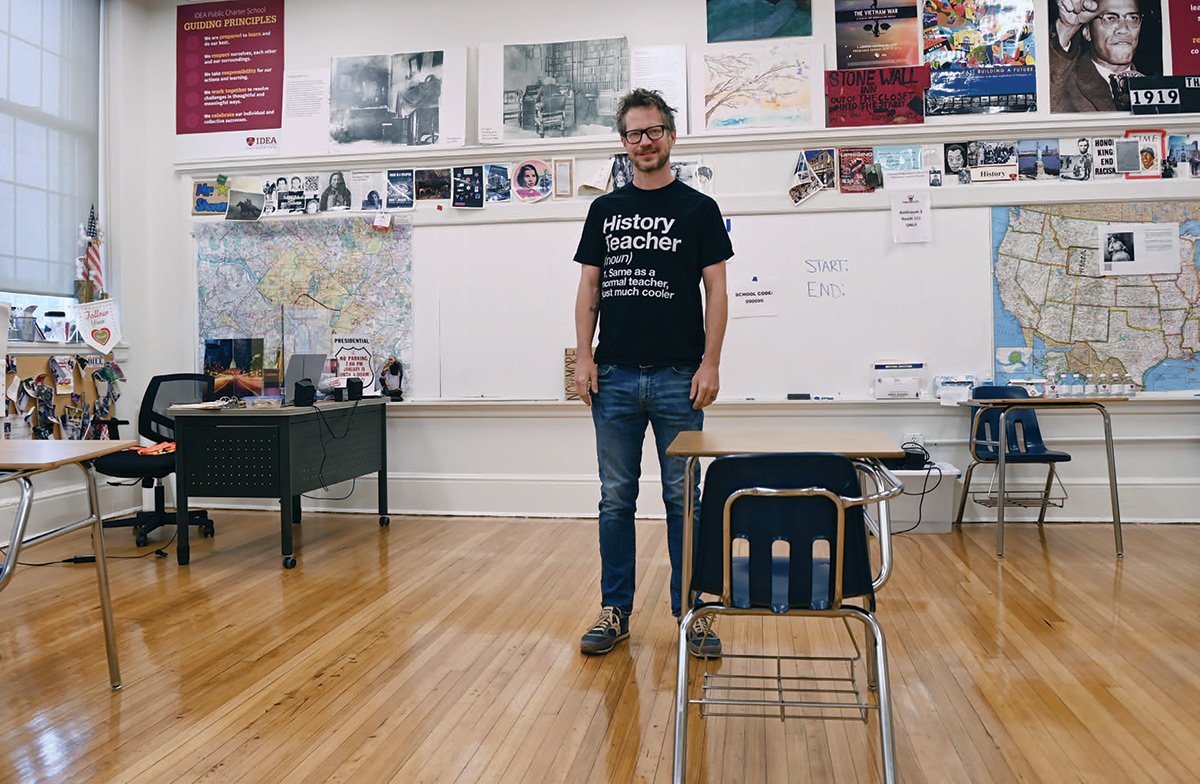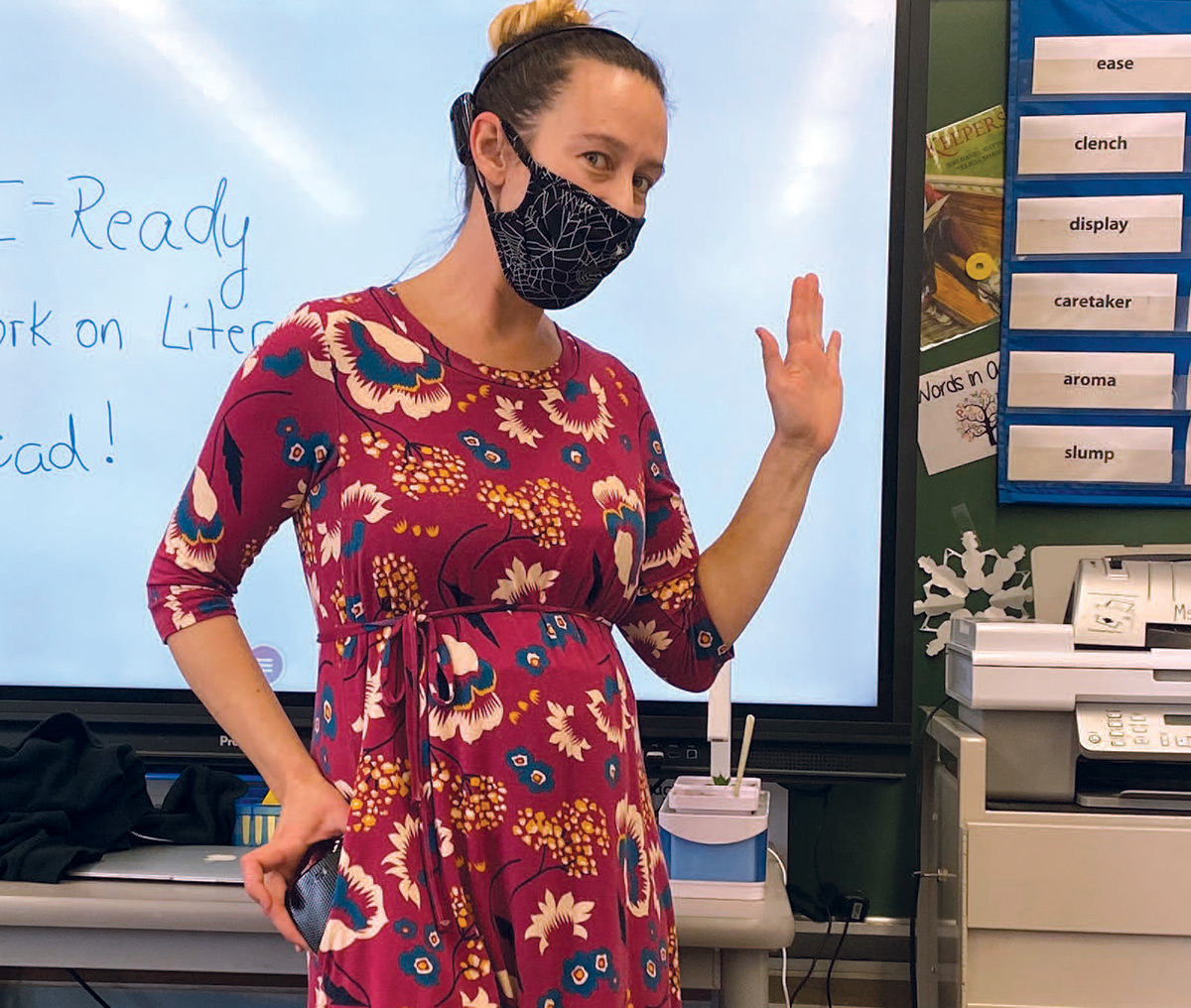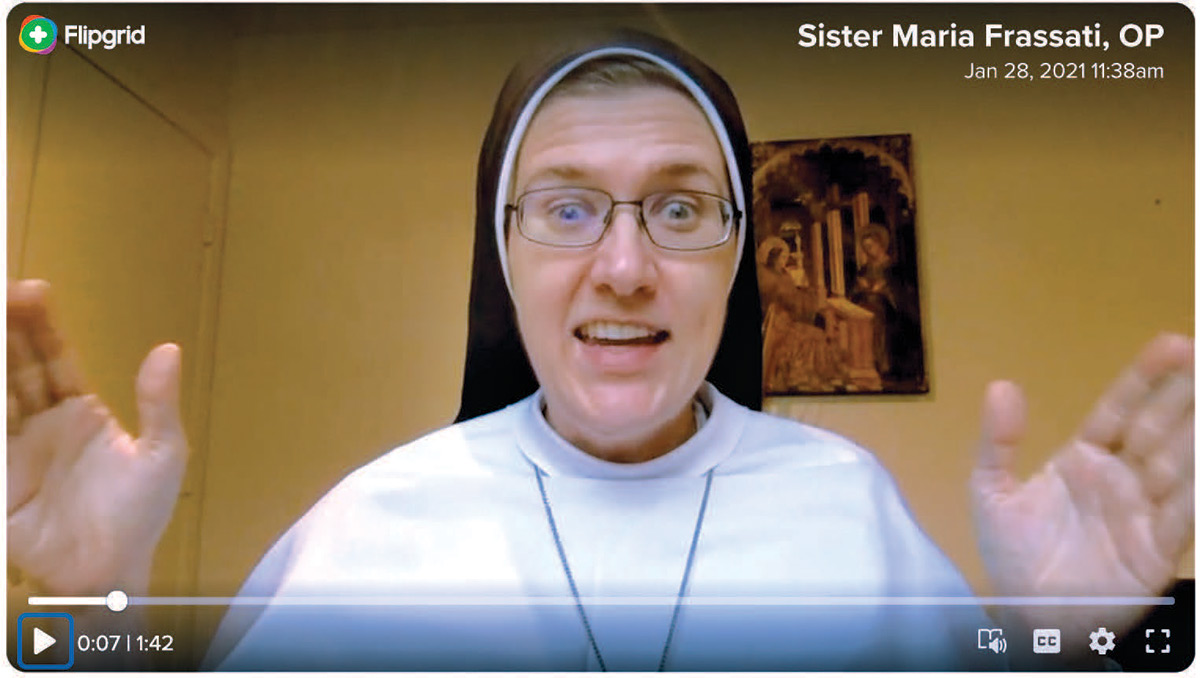

By Katie Bahr
Empty classrooms and online learning were a large side effect of the COVID-19 pandemic. For teachers, it has been a year of reinvention as they continue to find new ways to connect with their students in a virtual world.
Every Monday and Friday, Bill Stevens, M.A. 2010, sits down in front of his computer in an empty classroom at The IDEA Public Charter School in Washington, D.C. A social studies teacher, Stevens has been conducting his classes completely online since March of last year, in accordance with his school’s COVID-19 safety precautions.
“I teach my students in the same classroom where I taught last year,” he said. “I still have the same stuff on the walls. And some of the students I teach now have never even been in the building before. They don’t have an emotional connection to this place.”
Stevens has been working for 22 years as a teacher in D.C. and has been at IDEA for the past three. Previously, he was recognized by the New York-based Gilder Lehrman Institute of American History as the 2018 D.C. Teacher of the Year.

Bill Stevens, M.A. 2010
Like millions of other teachers around the United States, Stevens has spent the last year adjusting to an entirely new kind of classroom. He’s had to change his lesson plans and shift his expectations. And despite years of experience, he’s been left feeling like a total beginner.
Stevens compares teaching to working as a comedian. The first few years on the job, he says, are like performing standup comedy in front of an audience that responds quickly by laughing, heckling, or checking out. You must learn how to respond to the crowd and make tweaks as you go. This last year, he says, has been more like being a radio DJ.
“I’m putting stuff out over the airwaves and I have no idea what the reaction is because I don’t hear people laughing or see them rolling their eyes or smiling,” he says. “The relationship has been taken completely out of the game and I have to think of new ways to build that. And I need to wait for the grades to come in to find out if I’m effective.”
Stevens is just one of many CatholicU grads who have been forced to adjust their teaching careers for a socially distanced world. Though the experience has been extremely challenging, he — like so many hard-working teachers — has been determined to make it work.
For him, that means teaching from an empty classroom or — on the three days a week when he’s at home — juggling parenting responsibilities with work, and occasionally teaching from the laundry room.
“Out of the millions of teachers going through this same thing, I’m not dealing with it any more effectively than anyone else,” he says. “I’m lucky. I’m a middle class person where I have space and I can put each of my kids in a separate room, but it’s still distracting. My kids have made me teach from the laundry room, but what if I didn’t have a laundry room? Many people don’t.”

Sarah Washington, B.S. 2018, M.A. 2019, who participated in CatholicU’s 4+1 bachelor’s and master’s program in mathematics and secondary education, was in her first year of teaching honors Algebra II and Pre-calculus at Gonzaga College High School in Washington, D.C., when the coronavirus lockdowns began in March 2020.
Before her school closed, faculty members gathered for a professional development day to quickly learn how to use Zoom and create virtual learning modules. At the time, they were planning for two weeks of virtual instruction.
“The next few months were crazy,” Washington says. “We were treading water as best we could.”
Gonzaga, like many other schools, finished out the school year virtually. Then, this fall, the school opened up for hybrid learning — welcoming back 30% of their students in person, with additional students taking classes online.
As a new teacher, Washington has had to ride the waves of the ever-changing safety policies by reorganizing, replanning, and really shifting her teaching style. One of the biggest challenges has been figuring out how to keep a classroom of in-person students interested, while teaching to an online class at the same time.
“You want to keep the students in the classroom having a good time, but there are usually way more students on Zoom than in the real room so it’s this tricky kind of back and forth,” she says. “There are days where you’re thinking, ‘Are they just sitting at home playing Xbox? Are they learning anything?’”
One thing that has helped, Washington says, has been communicating early and often. She now shares her lesson plans ahead of time so that students understand what’s expected of them before they get to class. She’s also been finding new ways to assess student skills instead of simply giving math problems and expecting the right answers.
Though her first year on the job hasn’t been exactly what she envisioned, Washington says she feels a real purpose and passion for what she does.
“Being an essential worker, I definitely feel more important and more valued this year than I would have,” she says. “For worse or for better, there are some things we can all take away from this past year.”

Denise Getchius Staines, B.A. 2002, who studied elementary education at CatholicU, is a theatre teacher at Waterside Children’s Studio School in Queens, New York. A big challenge for her over this past year has been learning how to share a love of the arts with her students.
In order to keep her performance schedule on track — a fifth-grade musical, choir performances, and an eight-minute Shakespeare performance she plans with an outside organization — Staines figured out how to hold theatre rehearsals over Google Meet, all while handling childcare for her three children.
“During a lot of the rehearsals and some of my recordings, I’m actually holding my baby,” she says. “What else could I do?”
To continue the school’s Spring Arts Festival, she asked parents to record students dancing their individual parts and then she used iMovie and a program called Flipgrid to compile the individual pieces into two-minute performances for each grade. The entire project took more than 40 hours of her free time.
Staines moved the Shakespeare program, which she organizes with the nonprofit Creative Arts Team, to a radio show platform. And she directed her fifth-grade students in a Zoom version of Annie, which was recorded and played on Facebook.
For Staines, putting on the musical was about more than just art. She believes that theatre is “the best and only medium in helping students understand what their potential is.”
“As a theatre teacher, I get to see a side of a student that even the kid might not see in themselves,” she says. “And then I can put them on the stage and they turn into a star and everyone sees it — their teachers, administrators, and their families.”
Though these moments are more difficult to find through virtual learning, Staines says they have still happened.
“Because of Google Meet and Zoom, I could see the facial expressions of these students, or I’ll get thank you notes from the parents. You’re still able to see the feedback.”
Though the experience of teaching during a pandemic has been a lot of work, Staines says she feels a new sense of pride, after seeing how her students and fellow teachers have risen to the challenge.
“If I didn’t already know that teachers could do anything, I sure as heck know it now,” she says. “I was doing this for 10 years before I had to change everything. While it was happening, I was so focused on making sure I was doing the right thing and trying to give the kids the best experience possible.
“I don’t think it really hit me until afterwards what all had to go into it and just the sheer number of hours. I did a lot of work that looking back on it I can be proud of.”
As teachers have gained a new window into their students’ lives, they are also becoming more aware of the challenges they are facing, especially in cases of students with special needs or economic disadvantages.
Stevens works at a Title 1 school, which means at least 40% of the students are from low-income families. Often, he says, they are dealing with limited technology, hectic environments, and food insecurity.
“The inequities that have always been a part of our public education system grew during this past year,” he says. “You show up at someone’s house and you realize, here are three families living in a two-bedroom apartment. I’ve had students turn on their camera and it’s nearly impossible to hear them because of all the background noise that’s going on.”
Stevens and other staff at IDEA have spent time driving around the city to ensure his students have the food and equipment they need. Now when his students don’t do the required work, he looks at the bigger picture and the systemic societal problems that have exacerbated their difficulties.
“What I complain about now is not that my kids aren’t doing their work, it’s how come these kids don’t have the internet in the first place,” he says. “What’s happening is not their fault and intellectually I knew that before, but now I really know it.”
As an American history teacher, Stevens wants students to understand some of the circumstances which have led to today’s inequalities, as well as the people who are working to fix the problems. He draws inspiration for his teaching style from his history professors at CatholicU, who designed courses with his interests in mind.
“The teachers that touched me on a personal level reached out to me, tailored what they were doing to where I was, and offered support for the things I was interested in,” he says. “You need to engage people on a personal level and realize that there are many ways to get to the end goal.”

Will Rost, B.A. 2015, is a seventh and eighth grade social studies teacher at San Miguel School in Washington, D.C., an all-boys school that prepares academically and economically disadvantaged youths to succeed. One of the most important things he has gained during the pandemic is a deep sense of empathy for his students.
Rost knows that some of his students have had to take care of their younger siblings during school hours, or that they are embarrassed to have their camera on because of the other people in the room with them. In the early months, some students didn’t have access to the technology they needed.
“I’ve had students tell me, ‘Mr. Rost, I don’t have internet so I can’t complete the assignment today,’” he says. “In those situations, you have to say, ‘I understand. Let’s find a different way for you to complete this work,’ and that’s definitely a challenge. I couldn’t imagine being in sixth or seventh grade and going through what they’re doing.”
Rost says he is grateful for the framework of education he learned during his time in the CatholicU Department of Education.
“Part of the conceptual framework was teaching us how to be reflective practitioners,” Rost says. “Whenever a student isn’t at the mark where they should be, I try to reflect on what’s going on and remind myself of their situation. We have to keep our expectations realistic and keep the workload manageable, keeping in mind that they’re regulating themselves. Sometimes they are able to complete the task as expected and sometimes not.”
Despite the many hardships of the year, both Stevens and Rost say they are inspired by their students.
“They are doing what students are doing all over the world — trying their best in this situation they’ve been handed,” Stevens says. “Some are tuned out because they don’t know what to do, it’s too overwhelming. But others are trying to fix this situation, and thinking, ‘I want to make the world a better place because of this.’”
Sister Maria Frassati Jakupcak, O.P., Ph.D. 2020, teaches 10th and 12th grade English at Marin Catholic High School in Marin County, Calif. Like Washington, she’s been teaching hybrid classes this year as her school gradually brings more students back to the classroom.

Sister Maria Frassati Jakupcak, O.P., Ph.D. 2020
She thinks one of the biggest challenges has been a decrease in what she calls “life/school balance.” Just as it became hard for teachers to avoid the work of school from rushing into their home lives, it also became difficult for students to avoid the distractions of home from invading their school time.
“Many of my students who might struggle a little struggled a lot in this online mode of teaching,” she says. “If you are already prone to distraction and then you are supposed to do school on the same device that brings you Netflix, well, that is hard.”
That said, Sister Maria Frassati says she has been inspired by the resilience of her students.
“This isn’t the school year any of them wanted — either last year or this year,” she says. “But it is the school year they got and they have been fairly good about accepting that.”
Sister Maria Frassati found that some of her classwork actually had new relevance because of the pandemic. This year, she’s teaching a class on J.R.R. Tolkien and his ideas about fairy tales. Introducing her students to the fantastical world of The Lord of the Rings and asking them to write their own fairy tales provided a mental escape.
“Tolkien began his own work on what would become Middle Earth in the trenches of World War I. There was a great renaissance of interest in fairies about that time,” she says. “And it turns out that fairy stories — writing and reading them — are things particularly suited to troubled times.”
Another silver lining of virtual learning, she says, has been the opportunity to invite experts in the field to be guest speakers in her classroom. Sister Maria Frassati hopes to introduce her students to a friend with editing expertise, as well as Verlyn Fleiger, M.A. 1972, Ph.D. 1977, a leading Tolkien expert.
In her own time, Sister Maria Frassati has enjoyed being able to connect with her sisters from around the country. She was asked to teach a weeknight class on Shakespeare to a group of sisters in Michigan and was surprised when sisters from other states were also able to join the call.
“We are a teaching community, but we don’t often see each other teach,” she says. “Teaching always fits into my vocation, but I think all of this has made it clear that our teaching could easily have a reach outside our immediate classroom.”
Now that things are opening back up and she sees a light at the end of the tunnel, Sister Maria Frassati has simple advice for those going back into the classroom:
“Enjoy it,” she says. “I think one of the things the pandemic has given us is perspective to see how much we take for granted. Being in a classroom with other people, being able to go out with our friends — what a gift!”